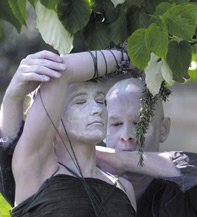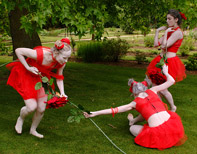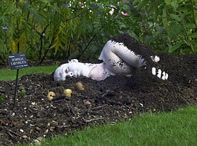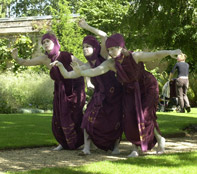
» café reason
» butoh
» diary
» new work
» past work
THEATRE WORK
SITE SPECIFIC WORK
»» landscape retreats
»» living library
»» botanic garden
»» tate modern
»» the forest that-
»» -sailed away
»» millennium walks
» classes
» contacts

May - Mint - the herb gardener
(Doro, Phil)

June - Rose - the rose thieves
(Doro, Fabrizia, Helen)

August - Potato
asleep in the mandrake bed
(Phil Rees)

August - Potato - nightshade trio
(Ayala, Fabrizia, Jeannie)
LIVING LIBRARY - 2004
Someone be the rose tree,
some be the wind's daughters,
some be the rose thieves"
(Vasco Popa)
In 2004, the Oxford Botanic Garden commissioned Café Reason to devise performances for their summer-long 'Living Library Festival' celebrating the diversity of the Plant Kingdom. Five themed days, each organised around one of the flowering plant families - Buttercup, Mint, Rose, Daisy, and Potato - marked their re-classification according to the latest molecular data and aimed to raise awareness of the importance of plant taxonomy in the search for new medicines. Having researched the botanical background to each family, we then drew upon their 'qualities' to create our movement. Bruno Guastalla devised an original sound accompaniment to each piece (performed variously by Malcolm Atkins, Bruno, Doro Wing, Joe Butler, Dominic Lash, Pete McPhail and Sarah Verney-Caird), and Aline Stanway made us magical willow structures that became in turn trellises, baskets, dresses, cages, and dream-catchers.
Buttercup (Ranunculaceae)
In evolutionary terms, this is a rather primitive group which includes anemone, aquilegia, hellebore, clematis, aconite, nigella, and delphinium. Most of the species are ornamental spring flowers but some, such as monkshood, are highly poisonous. We decided that the Buttercup qualities were modest and creeping, but devious. As this was the first of the five performances, our movement also played with ideas of formality and structure. Three voices in three languages read a medley of botanical texts relating to the Ranunculus genus, while a very pregnant Ana was borne aloft as the fertile spirit of the garden.
Mint (Labiaceae)
This family consists of mostly aromatic plants such as mint, basil, sage, thyme, rosemary, lavender, and oregano, which are cultivated as ornamentals and kitchen herbs; they are important sources of essential oils for perfumery and pharmacy. Focusing on their soothing, uplifting, and spiritual qualities, our Mint dance was an evocation of calm and order, featuring a zealous gardener transplanting, pruning and tending his dreamy, beautiful butoh plants.
Rose (Rosaceae)
This large group of mainly fruiting plants includes - besides rose - potentilla, alchemilla, quince, plum, apricot, cherry, apple, pear, strawberry and blackberry. Rose is the 'queen of flowers', the most widely cultivated garden flower worldwide. We decided that her contrasting qualities were those of opulence, romance, and prickliness. Inspired by Vasco Popa's poem The Rose Thieves, the four 'wind's daughters' set off from the cardinal points of the garden carrying immense roses, while the 'rose thieves' burrowed under their crinoline skirts to steal them. Baskets of rose petals, poems and strawberries were produced and offered to the audience.
Daisy (Asteraceae)
One of largest groups of flowering plants: sunflower, dandelion, thistle, ragwort, chrysanthemum, dahlia, and marigolds and, surprisingly, lettuce, are all in the daisy family. Choosing the open, sunny, ubiquitous, brash, persistent and generally thuggish qualities for this group, we brought on a charge of three marauding clowns, juggling (badly) with assorted objects, wrestling with each other, chasing among the flowerbeds, and annoying the audience. Rough, tough and impossible to get rid of, but, turning to the sun, gradually synchronizing flower movements, Daisy ended in quiet contemplation through suspended willow hoops - he loves me, he loves me not.
Potato (Solanaceae)
This family has two very contrasting temperaments. It includes important vegetables such as potato, aubergine, tomato, and sweet pepper, as well as tobacco, and a collection of notoriously poisonous plants such as belladonna (deadly nightshade), mandrake, and black henbane. In this last chapter of the Living Library we played with the contrasts of nourishing versus deadly, while Phil the potato man lay buried among among the mandrake roots, toy babies were unearthed from the flower beds, and the spirit of the garden, reincarnated as the haughty Bella Donna, returned robed in a crackling, shimmering cloak of crisp packets, carrying her newborn little 'spud'.